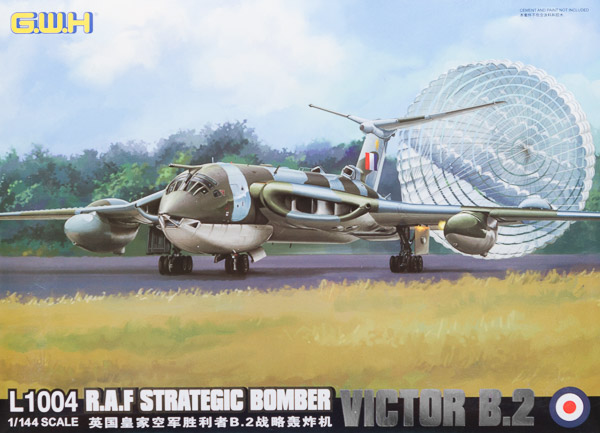
Great Wall Hobby 1/144 RAF Strategic Bomber Victor B.2
By Chris Banyai-Riepl
Overview
Alongside the Avro Vulcan and Vickers Valiant, the Handley Page Victor was one of the RAF's famous V-Bombers forming part of Britain's airborne nuclear deterrent. While the Victor remained in this role for a short time, it received a much longer lease on life as an air tanker. As tankers, the Victor remained in RAF service until the 1990s.
The Kit
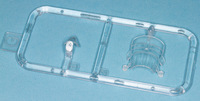 Great Wall Hobby continues to hit 1/144 scale with British bombers with their latest release of the Handley Page Victor. For those familiar with their 1/144 Vulcan kits, this one is similar in detail, with finely recessed panel lines, plenty of detail including an interior, and a nice decal sheet that includes markings for three options.
Great Wall Hobby continues to hit 1/144 scale with British bombers with their latest release of the Handley Page Victor. For those familiar with their 1/144 Vulcan kits, this one is similar in detail, with finely recessed panel lines, plenty of detail including an interior, and a nice decal sheet that includes markings for three options.
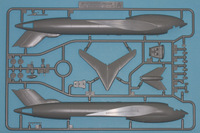 Jumping into the construction, the overall build process is very straightforward, but well engineered. There is a cockpit included, with a couple of seats molded in place in a one-piece tub. Not much detail is here, but in this scale and through those small windows, not much can be seen. That said, there are no instructions on what colors to paint the interior, so some additional research will be needed. A quick Internet search suggests that the interior should be black, with green or tan cushions and blue or tan belts on the seats.
Jumping into the construction, the overall build process is very straightforward, but well engineered. There is a cockpit included, with a couple of seats molded in place in a one-piece tub. Not much detail is here, but in this scale and through those small windows, not much can be seen. That said, there are no instructions on what colors to paint the interior, so some additional research will be needed. A quick Internet search suggests that the interior should be black, with green or tan cushions and blue or tan belts on the seats.
 Other bits for inside the fuselage include the nose gear well and an insert for the rear fuselage air brakes. The latter can be skipped if you choose to display those brakes closed. The instructions also indicate that you will need 3.5 grams of weight to keep this one on its nose gear. Luckily, there is plenty of space in the nose for this weight, and you will have no problem finding places to stash it. With all those bits in place, you can button up the two fuselage halves and add the two clear pieces for the main windscreen and lower nose windows, as well as the one-piece bomb bay door section.
Other bits for inside the fuselage include the nose gear well and an insert for the rear fuselage air brakes. The latter can be skipped if you choose to display those brakes closed. The instructions also indicate that you will need 3.5 grams of weight to keep this one on its nose gear. Luckily, there is plenty of space in the nose for this weight, and you will have no problem finding places to stash it. With all those bits in place, you can button up the two fuselage halves and add the two clear pieces for the main windscreen and lower nose windows, as well as the one-piece bomb bay door section.
For the flying surfaces, we'll start with the simple one, the horizontal stabilizer. The stabilizer is built up from four pieces, with the one-piece upper section accurately capturing the sharp dihedral of the stabilizer. The forward bullet and rear fairing are also separate, and the finished stab fits nicely onto the vertical fin.
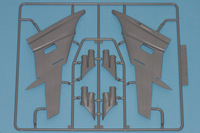 The wings are a bit more complex, but the engineering of the kit takes it all in stride. Each wing is split into upper and lower halves, with the upper wing halve incorporating the outboard wing leading and trailing edge undersides. The completed wing fits into a cutout in the fuselage, making for a near perfect fit that will require no filler. Before putting the wing together, though, you'll have to add the exhaust pipes, which are molded individually, and the intakes, which are split into upper and lower halves and feature separate engine faces. While these will have some seams to fill on the sides, the overall engineering of the intakes is very nice and the finished intakes fits into the wing as best as could be expected. Like the cockpit, though, there are no painting instructions for what color should be on the inside of the intakes. Add the large underwing tanks and this is looking every bit like a Victor.
The wings are a bit more complex, but the engineering of the kit takes it all in stride. Each wing is split into upper and lower halves, with the upper wing halve incorporating the outboard wing leading and trailing edge undersides. The completed wing fits into a cutout in the fuselage, making for a near perfect fit that will require no filler. Before putting the wing together, though, you'll have to add the exhaust pipes, which are molded individually, and the intakes, which are split into upper and lower halves and feature separate engine faces. While these will have some seams to fill on the sides, the overall engineering of the intakes is very nice and the finished intakes fits into the wing as best as could be expected. Like the cockpit, though, there are no painting instructions for what color should be on the inside of the intakes. Add the large underwing tanks and this is looking every bit like a Victor.
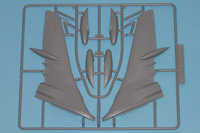 The remainder of the assembly is all the fiddly bits. For the fuselage, this includes a separate refueling probe, nose ECM bumps, rear cooling vents, and upper fuselage antennae including the prominent towel rack antenna over the wings. For the wings, there are a few scoops on the underside as well. The majority of the small details, though, revolve around the landing gear. The nose gear has separate wheels, a three-piece strut, and separate fenders. The main gear features a nice way of doing the double wheels, with one wheel including both hubs and the second tire sliding over that. The strut is sturdy, built from two pieces, and given the rest of the engineering of this kit, there is likely not going to be any issues with having all the wheels on the ground with this one.
The remainder of the assembly is all the fiddly bits. For the fuselage, this includes a separate refueling probe, nose ECM bumps, rear cooling vents, and upper fuselage antennae including the prominent towel rack antenna over the wings. For the wings, there are a few scoops on the underside as well. The majority of the small details, though, revolve around the landing gear. The nose gear has separate wheels, a three-piece strut, and separate fenders. The main gear features a nice way of doing the double wheels, with one wheel including both hubs and the second tire sliding over that. The strut is sturdy, built from two pieces, and given the rest of the engineering of this kit, there is likely not going to be any issues with having all the wheels on the ground with this one.
The decal sheet is small but comes with lots of nice details. There is a good bit of stenciling, including various walkway markings and rescue markings. The national insignia are of the red/white/blue variety, while the individual markings cover three different Victors. The camouflage scheme consists of gray and green over light gray, and the color instruction sheet provides a nice four-view drawing that will aid greatly in masking the camouflage scheme.
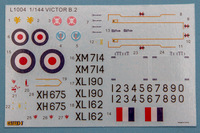 For marking options, you get both Victor B.2 units: 100 Squadron and 139 Squadron, with the latter having two different tail emblem options. The first of the 139 Squadron aircraft is XL190 with a lion emblem on the tail. This plane served with 139 Squadron from 1962 to 1964, when it was transferred to the Wittering Wing and converted to carry the Blue Steel. In 1970 this plane was again converted, this time to K.2 tanker status. In 1993 the plane was retired to a ground trainer, and the nose section is currently preserved at Manston. Following a similar path is the second 139 Squadron aircraft, XL162, which features the squadron emblem on the tail. Delivered in 1963 to 139 Squadron, transferred to Wittering in 1965 and converted to Blue Steel, tanker conversion in 1970, and withdrawn from service in 1986.
For marking options, you get both Victor B.2 units: 100 Squadron and 139 Squadron, with the latter having two different tail emblem options. The first of the 139 Squadron aircraft is XL190 with a lion emblem on the tail. This plane served with 139 Squadron from 1962 to 1964, when it was transferred to the Wittering Wing and converted to carry the Blue Steel. In 1970 this plane was again converted, this time to K.2 tanker status. In 1993 the plane was retired to a ground trainer, and the nose section is currently preserved at Manston. Following a similar path is the second 139 Squadron aircraft, XL162, which features the squadron emblem on the tail. Delivered in 1963 to 139 Squadron, transferred to Wittering in 1965 and converted to Blue Steel, tanker conversion in 1970, and withdrawn from service in 1986.
For the 100 Squadron aircraft, XM714, this aircraft had a shorter history. The plane took to the skies for the first time on October 16, 1962, and was delivered to 100 Squadron the following month. On March 20, 1963, XM714 took off from RAF Wittering and stalled during the climb out, killing all five crewmen. This plane carried the skull and crossbones marking of 100 Squadron on the vertical fin. The decals are very nicely printed, with good color and alignment.
Conclusion
Overall, this is an excellent kit of the Victor. In fact, if Great Wall Hobby scaled this up to 1/72 and added just a bit of extra detail in the cockpit, we'd have a kit far better than the Matchbox kit. The engineering is excellent, a fact highlighted by the fact that I tore into the kit and have it close to painting stage after only an hour's work or thereabouts. The only thing that slowed things down was the lack of color information on the interior bits, both the cockpit and intakes. Given the nice detail, simple construction, and colorful options, this will be a popular kit and undoubtedly we will see a tanker version and perhaps a Blue Steel version. My thanks to Dragon Models USA for the review sample.
